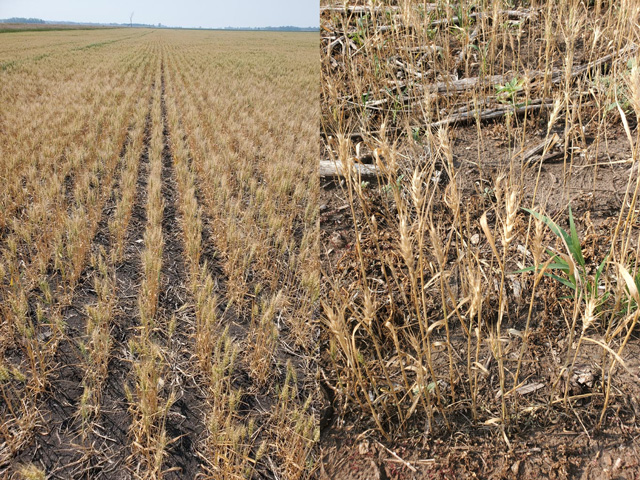Cash Market Moves
2021 Spring Wheat Tour: Scouts Ready to Head Out
The Wheat Quality Council tour will take place starting Tuesday, July 27, when scouts head out across the state, following eight standard routes beginning and ending in Fargo, North Dakota, with overnight stops in Bismarck and Devils Lake. During the 2019 tour, Dave Green, Executive Vice President of Wheat Quality Council noted, "We change car assignments each day and try to have some expertise in each car to train those inexperienced. We are joined each night by local producers, agronomists and grain handlers to offer local insight. We use yield formulas supplied by North Dakota State University and take an average of all of our stops and report it to the trade."
The 2020 Wheat Quality Council's Annual Spring Wheat Tour was not a "hands on" event due to COVID-19, but instead, the North Dakota Wheat Commission (NDWC) and North Dakota Grain Growers (NDGGA) hosted a virtual hard red spring wheat pre-harvest update.
Given the severe and ongoing drought in North Dakota, scouts will run into many poor fields of spring wheat and durum. Some of those wheat fields may have already been abandoned and hayed because the crop never had a chance to flourish given the very hot and dry summer there and in other spring wheat areas of South Dakota and northwest Minnesota. Fields that were hayed were much needed feed for cattle producers struggling to keep their cattle fed given the extremely poor pasture conditions and lack of fields normally used for hay.
This year, Green told DTN that he's trying to be open minded to conditions, but pictures and crop ratings look bleak. "Abandonment is always hard for a wheat tour to quantify." Green said there are around 45 people in 12 cars partaking in the tour this year on the eight routes.
The most recent USDA crop conditions report in North Dakota had spring wheat condition rated 30% very poor, 34% poor, 25% fair, 10% good and 1% excellent. Durum wheat condition was rated 13% very poor, 25% poor, 29% fair, 27% good and 6% excellent.
I spoke with Darin Jantzi, State Statistician, USDA/NASS North Dakota Field Office, about how abandoned and hayed spring wheat acres would be accounted for this year by USDA. "From now until the Small Grains Annual Summary is published in late September, NASS really doesn't have any mechanism to account for any abandoned acres or any other unharvested acreage for any crops. The monthly Ag Yield Surveys are designed for the specific purpose to forecast yields. So, even though we ask for harvested acreage on those surveys, it is done for the sole purpose to calculate yields and not to make any harvested acreage revisions."
P[L1] D[0x0] M[300x250] OOP[F] ADUNIT[] T[]
Jantzi added, "Also, we would need to survey many more producers each month to publish any harvested acreage estimates, and that isn't done since that isn't what those surveys are designed to do. Therefore, any abandoned wheat acres won't be fully known until we collect that data from producers in early September. That is when we collect final acreage and production data once the producers have harvested their small grain crops."
As for the hayed acres, Jantzi said that, "The first opportunity for estimates to be made on abandoned wheat acres being hayed would be in the October Crop Production report. There is no estimate for hayed grain acres as they all just show up in the 'Other Hay' acreage and yield forecast. The final 'Other Hay' estimates would be in the Annual Crops Summary published in January."
SPRING WHEAT FARMERS WEIGH IN
I have written at least three stories on the devastating drought conditions and the effect it is having on the spring wheat crops in North Dakota, South Dakota and northwest Minnesota. I spoke to the same growers each time and the comments only got worse. Here is an update from some of those farmers.
On July 23, Allan Klain, Turtle Lake, North Dakota, told me that he is spraying down fields for harvest ability. "My best fields are not good. Kernels will be light and there will be fewer bushels. On the fields I thought I could do 20 bushels per acre (bpa), it will be 5 to 10 bpa tops, and there will be plenty of test weight deductions. West of us in the Garrison area, I've heard of fields appraised at 1 to 2 bpa. It's a moonscape there. Turn it over to crop insurance and lock the bins if the test weight discounts get out of hand."
Just west of Klain is Paul Anderson in Coleharbor, North Dakota, who told me in mid-June that he was planning to tear up 900 acres of wheat and plant corn. "We never got done in time to replant the wheat with corn and didn't get enough rain to even make that happen." That field he is talking about is pictured in this story and you can see why he wanted to terminate it.
Tim Dufault, Crookston, Minnesota, said this past week that he saw the first field of spring wheat being harvested 10 days earlier than normal. "I heard of the first yield report of a different Polk county wheat field at 15 bpa versus the county average of over 60 bpa. My average crop is 68-70 bpa range and I'm hoping to make at least 35 to 40 bpa."
The tour will begin on Tuesday, July 27, and will conclude midday Thursday, July 29.
Here are links to the most recent drought stories published on DTN that can give you a good picture of what scouts will be seeing:
Mary Kennedy can be reached at mary.kennedy@dtn.com
Mary Kennedy can be reached at mary.kennedy@dtn.com
Follow her on Twitter @MaryCKenn
(c) Copyright 2021 DTN, LLC. All rights reserved.




